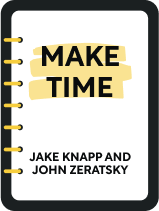

This article is an excerpt from the Shortform book guide to "Make Time" by Jake Knapp and John Zeratsky. Shortform has the world's best summaries and analyses of books you should be reading.
Like this article? Sign up for a free trial here .
What is the book Make Time about? What are the main takeaways of the book?
In Make Time, Jake Knapp and John Zeratsky argue that we live in an information landscape designed to steal our time and attention. To escape from all of our modern distractions, you must be proactive to take back your time.
Read below for a brief overview of the book Make Time.
Make Time by Jake Knapp and John Zeratsky
If there’s one word that best describes modern life, it’s “frazzled.” People today feel overwhelmed by work, endless meetings, other peoples’ demands, and to-do lists that never stop growing. Meanwhile, it’s impossible to focus on any single task without being interrupted by phone calls, emails, social media, the news, and an information landscape that’s purposefully designed to grab your ears and eyeballs. It takes a conscious effort to reclaim your life, your attention, and control of your time.
Tech industry insiders Jake Knapp and John Zeratsky propose that by making straightforward adjustments to your lifestyle, you can wrest control away from the thousand distractions that chip away at your time, leaving you free to focus on the things you care about most. As opposed to streamlining life’s small-level details or worrying about long-term goals and ambitions, the authors find a middle ground: identifying one central task as the focus of each day and arranging your time and energy to support that key activity.
In their book Make Time, the authors freely admit to having been part of the problem they’re trying to solve. They both spent years designing products for the information industry, and they had front-row seats in the Big Tech competition to grab clicks, likes, views, and downloads. When they realized the effects the electronic rat race was having on their own lives, they began to think about applying their design skills to managing time itself. Through this process, they found ways to pour energy back into their personal aspirations.
Focus Your Attention
We spend most of our days reacting to a barrage of intrusions and demands: emails, phone calls, and notifications, not to mention other human beings encroaching on our time with action items, meetings, committees, and chores. Even when we squeeze in some time of our own, the siren call of social media, 24-hour news, and TV tricks us into frittering away the hours we otherwise might have spent pursuing some long-forgotten goal or dream.
Protect Your Focus
Once you’ve established your Focus and learned what practical methods will help keep you “in the zone,” you’ll still need to fend off all the distractions that will try to tear your attention away. To do that, you’ll need to set healthy boundaries—not just for other people, but for all the technology you’ve come to rely on: your computer, your TV, your WiFi, and most of all your phone. In their book Make Time, Knapp and Zeratsky suggest dozens of strategies to limit the ways that colleagues and devices can distract you from your Focus. Some techniques are simple and some are extreme, but all are based on the central premise that your time is more important than the latest shiny thing shouting for your attention.
Create Energy Through Self-Care
Once you’ve selected your Focus for the day and set healthy boundaries to ward off distraction, you’ll still have a hard time pursuing what’s important if your body and mind don’t have the energy to engage. Many of us spend a lot of our time feeling beaten down and exhausted.
Knapp and Zeratsky say that this is because the human body isn’t designed for our modern, sedentary, staring-at-screens lifestyle. They argue that in some ways, we were all better off as hunter-gatherers. Technology has brought us many wonders that we’d never dream of giving up (not to mention health care), but the evolution of our bodies has been unable to keep pace with the changes in lifestyle that have occurred since the agricultural revolution.
Knapp and Zeratsky suggest that to bring energy to your Focus, you need to take steps to align yourself with the active way of life that your body and mind are designed for. They give guidelines about how to make realistic changes to your level of activity, the kind of food you eat, and the way you relax to recharge your batteries so that you can give your Focus your all.
Implementing the Make Time Strategy
The sheer scope of Knapp and Zeratsky’s recommendations in their book Make Time will no doubt seem overwhelming at first. Setting priorities and boundaries, changing your digital habits, and learning to lead a healthier lifestyle are each, on their own, monumental tasks. Thankfully, you shouldn’t expect to tackle any or all of it at once.
The author’s tips and suggestions are merely that. By trying what works and what doesn’t for you personally, you can incrementally rearrange your life in a way that will be transformative over time. To begin, you might only pick one recommendation to follow from each of the three big categories: selecting your Focus, protecting your Focus, and taking care of yourself. Keep doing the ones that work; forget the ones that don’t. Since the last thing you want is to add to your to-do list, the best tips to employ are the ones that fit into your life with the least amount of hassle.
The key is to set realistic expectations for yourself, try out some of the authors’ suggestions, and look back every day on what worked and what didn’t. While beginning the process of gradual change, the authors recommend keeping a daily log of your progress. Record whether you completed your Focus, which tactics you employed, and how you might tweak them to your advantage. Also be sure to write down moments you enjoyed, and how you might be able to repeat them.
Instead of being a chore, taking notes makes you more aware of how you’re spending your energy and attention. Knapp and Zeratsky insist that keeping a log doesn’t need to be a permanent to-do item, but it does keep you mindful that making small changes has a snowball effect that will let you claim more and more control of your time.
Above all, remember that “Perfect is the enemy of good.” Any process of self-improvement will inevitably run over bumps in the road, and the industry of technological distraction continues to sharpen its tools. Don’t expect every day to go as planned, and don’t expect that you won’t indulge in old habits now and then.
In conclusion, Knapp and Zeratsky’s goal isn’t to help you be more efficient or productive or to add more chores to your to-do list. Their purpose is to help you make more time for what matters. The more you’re able to do that for yourself, the more paths will open, and whatever you’ve dreamed of “someday making time for” may come within reach sooner than you expect.

———End of Preview———
Like what you just read? Read the rest of the world's best book summary and analysis of Jake Knapp and John Zeratsky's "Make Time" at Shortform .
Here's what you'll find in our full Make Time summary :
- How the current landscape is designed to steal your time and attention
- How to be proactive to take back your time
- Why we were all better off as hunter-gatherers






